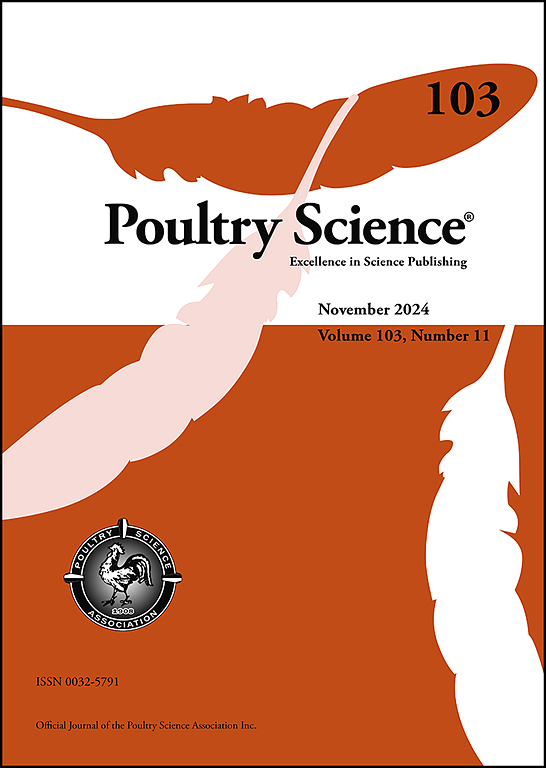研究说明:利用高分辨率气相色谱/质谱法对标记了 34S 的鸡组织进行化合物特异性同位素分析
IF 3.8
1区 农林科学
Q1 AGRICULTURE, DAIRY & ANIMAL SCIENCE
引用次数: 0
摘要
许多食品补充剂包括含硫添加剂,如蛋氨酸或合成化合物,如2 -羟基-S-甲基硫丁酸(HMTBA)。然而,监测含硫添加剂的代谢利用效率是具有挑战性的,并且需要基于同位素标记的特定方法。最直接的途径是利用富含34s的物质,随后测量组织中的34s丰度。虽然这可以使用元素分析和同位素比质谱(IRMS)对原料组织中的大块S进行常规分析,但目前还没有基于IRMS的方法适合于化合物特定的硫同位素分析。在这里,我们提出了一种基于气相色谱-高分辨率质谱(GC-MS)的方法来测量游离和蛋白质结合的含S氨基酸的34s丰度。该方法阐述了基于GC-MS分析三甲基硅化提取物的代谢组学。可以识别含有硫原子的特定离子碎片,并使用它们的同位素模式计算% 34S。高分辨率有助于避免天然碳(13C2)或(18O)同位素的混淆效应,但需要对硅(Si)同位素进行校正,因为30Si (+ 1.9968 a.m.u)的质量过剩与34S (+ 1.9957 a.m.u)接近,因此30Si和34S同位素无法分离。将该技术应用于饲喂了34S标记蛋氨酸的肉鸡,结果表明34S在不同器官中可以很容易地追踪到。由于食物中半胱氨酸的同位素稀释,34s -蛋氨酸主要重新分配给同型半胱氨酸,而在半胱氨酸和牛磺酸中34s -富集较少。结果表明,该方法可用于跟踪蛋氨酸等含硫添加剂在肉鸡体内的代谢掺入。本文章由计算机程序翻译,如有差异,请以英文原文为准。
Research note: Compound-specific isotopic analysis in 34S-labelled chicken tissues using high resolution gas chromatography/mass spectrometry
Many food supplements include sulphur (S)-containing additives such as methionine or synthetic compounds like 2‑hydroxy-S-methyl-thiobutyric acid (HMTBA). However, monitoring the metabolic use efficiency of S-containing additive is challenging, and requires specific methods, based on isotopic labelling. The most direct route is the utilisation of 34S-enriched material and subsequent measurement of 34S-abundance in tissues. While this can be carried out routinely using elemental analysis coupled with isotope ratio mass spectrometry (IRMS) for bulk S from raw tissue material, there is currently no IRMS-based method adapted to compound-specific isotopic analysis for sulphur. Here, we present a method based on gas chromatography coupled to high resolution mass spectrometry (GC-MS) to measure 34S-abundance in both free and protein-bound S containing amino acids. This method elaborates on metabolomics based on GC-MS analysis of trimethylsilylated extracts. Specific ion fragments comprising a sulphur atom could be identified and their isotopic pattern was used to compute % 34S. The high resolution was useful to avoid the confounding effect of natural carbon (13C2) or (18O) isotopologues but required a correction for silicium (Si) isotope because the mass excess of 30Si (+ 1.9968 a.m.u.) was close to that of 34S (+ 1.9957 a.m.u.) and therefore the 30Si and 34S isotopologues could not be separated. This technique was applied to broilers fed with 34S-labelled methionine and showed that 34S could be easily traced in different organs. 34S-methionine redistributed mostly to homocysteine with little 34S-enrichment in cysteine and taurine, due to the isotopic dilution by food cysteine supply. The results show that our method can be implemented to follow the metabolic incorporation of S-containing additives such as methionine in broilers.
求助全文
通过发布文献求助,成功后即可免费获取论文全文。
去求助
来源期刊

Poultry Science
农林科学-奶制品与动物科学
CiteScore
7.60
自引率
15.90%
发文量
0
审稿时长
94 days
期刊介绍:
First self-published in 1921, Poultry Science is an internationally renowned monthly journal, known as the authoritative source for a broad range of poultry information and high-caliber research. The journal plays a pivotal role in the dissemination of preeminent poultry-related knowledge across all disciplines. As of January 2020, Poultry Science will become an Open Access journal with no subscription charges, meaning authors who publish here can make their research immediately, permanently, and freely accessible worldwide while retaining copyright to their work. Papers submitted for publication after October 1, 2019 will be published as Open Access papers.
An international journal, Poultry Science publishes original papers, research notes, symposium papers, and reviews of basic science as applied to poultry. This authoritative source of poultry information is consistently ranked by ISI Impact Factor as one of the top 10 agriculture, dairy and animal science journals to deliver high-caliber research. Currently it is the highest-ranked (by Impact Factor and Eigenfactor) journal dedicated to publishing poultry research. Subject areas include breeding, genetics, education, production, management, environment, health, behavior, welfare, immunology, molecular biology, metabolism, nutrition, physiology, reproduction, processing, and products.
 求助内容:
求助内容: 应助结果提醒方式:
应助结果提醒方式:


